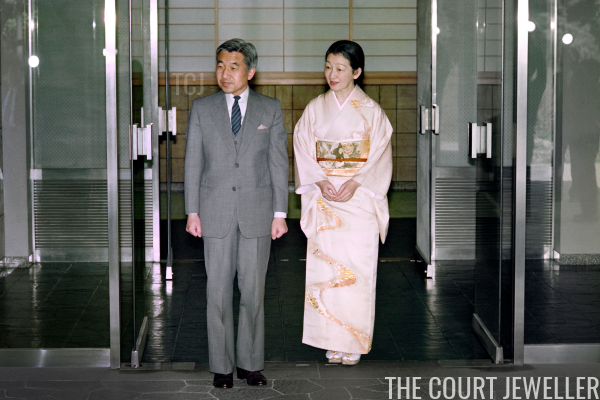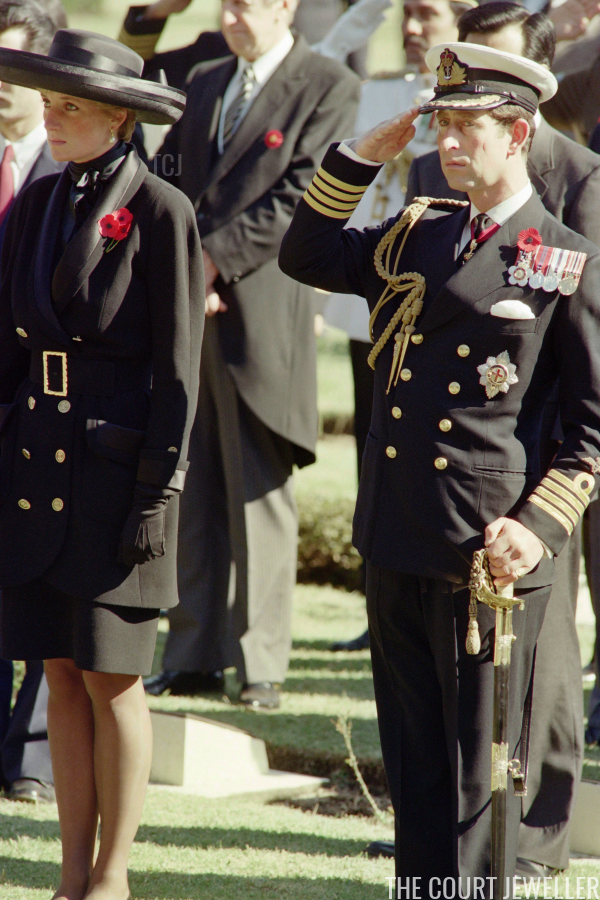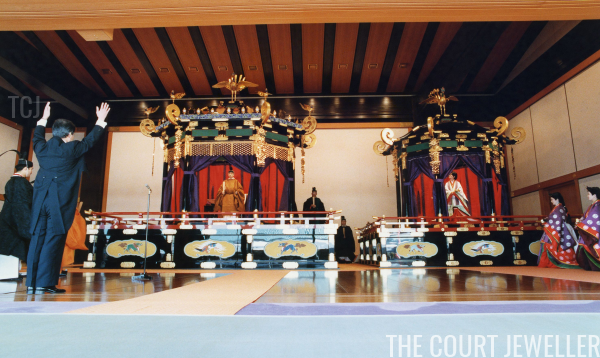 |
| KAZUHIRO NOGI/AFP/Getty Images |
Today in Tokyo, the world will watch as Emperor Naruhito and Empress Masako of Japan are officially enthroned. I’ll have a full post on the festivities later today, but first, here’s a look back at his father and mother’s enthronement ceremony, which took place almost thirty years ago.
 |
| AFP/Getty Images |
Crown Prince Akihito and Crown Princess Michiko became Emperor and Empress of Japan on the death of his father, Emperor Hirohito, in January 1989. More than a year passed before Akihito was officially enthroned on November 12, 1990.
 |
| AFP/Getty Images |
On November 8, the Imperial Household Agency released formal portraits of the new emperor and empress in Western-style gala dress ahead of their enthronement. Akihito was pictured wearing the collar and star of the Order of the Chrysanthemum; the sash, badge, and star of the Order of the Paulownia Flowers, and the star of the Order of the Sacred Treasures.
 |
| AFP/Getty Images |
An official portrait of Empress Michiko in gala dress was also published. She wore the grand Meiji Tiara, one of the most important Western-style jewels in the Japanese imperial vaults. She also wore the sash and star of the Order of the Precious Crown.
 |
| Charles and Diana visit a Commonwealth war cemetery in Yokohama on the day before Emperor Akihito’s enthronement, November 1990 (KAZUHIRO NOGI/AFP/Getty Images) |
More than 150 official guests flocked to Tokyo for the festivities, but two in particular captured the attention of the Japanese public. The correspondent for the Sydney Morning Herald wrote, “Prince Charles and Princess Diana have come to town for the Japanese enthronement and their presence is the cause for much celebration by the local tabloid press, television networks and their audiences. So charmed are Japan’s popular media by the British royals, especially Princess Diana, that poor Emperor Akihito now appears in some danger of scoring second billing at his own enthronement ceremony.” Television networks, which were required to air the ceremonies, supposedly even instructed their camera operators to focus on Diana in a bid to boost ratings, as many members of the Japanese public noted that they weren’t enthusiastic about the enthronement itself.
 |
| AFP/Getty Images |
On the morning of November 12, Emperor Akihito began the day with a private ceremony at a Shinto sanctuary inside the Imperial Palace.
 |
| AFP/Getty Images |
During the early morning ceremony, Akihito prayed; he also reported his enthronement to his ancestors and imperial deities.
 |
| AFP/Getty Images |
After completing the morning ceremony, Akihito changed into the highly symbolic traditional garments worn for the enthronement ceremony. One syndicated American press report described his attire: “The emperor wore a bulky robe of stiffened, reddish-brown silk, called a korozen no goho, woven with a complex pattern of paulownia trees, bamboo, legendary phoenixes and mythical animals known as kirin.” The imperial household released a formal portrait of Akihito in his enthronement attire before the ceremony.
 |
| JAPAN POOL/AFP/Getty Images |
The enthronement itself took place inside the imperial palace. The emperor and empress both stood atop lacquered platforms surrounded by curtains and topped by golden phoenixes. After being seated in a simple chair, the emperor was presented with a wooden scepter.
 |
| AFP/Getty Images |
Like Emperor Akihito, Empress Michiko wore traditional clothing for the enthronement. Press reports described her attire as “a five-layered red silk damask costume embroidered with a floral motif and covered by a white tunic and apronlike garment.” She also held a ceremonial fan during the proceedings.
 |
| JIJI PRESS/AFP/Getty Images |
The Japanese prime minister plays a central role in the enthronement ceremony, acting as the representative of the Japanese people. In 1990, Prime Minister Toshiki Kaifu led the traditional cheer at the end of the enthronement, shouting “banzai” three times. (It’s worth noting that press outlets around the world at the time placed special significance on the cheer, which is essentially a wish for long life for the emperor, during Akihito’s enthronement. His was the first enthronement in 62 years, and in the interim, the term banzai took on a different level of significance, having been used as a battle cry during World War II.)
 |
| AFP/Getty Images |
The other senior members of the imperial family were also present at the palace for the festivities. All three of the emperor and empress’s children — Crown Prince Naruhito, Prince Akishino, and Princess Nori — attended the ceremony, along with their brand-new daughter-in-law, Princess Akishino. (Fumihito and Kiko, formally known as Prince and Princess Akishino, married in June 1990. At this point, Naruhito was still in the process of wooing his future wife, Masako Owada. Meanwhile, Sayako, formally known as Princess Nori, would remain a member of the family until she married Yoshiki Kuroda in November 2005.) Also shown in this photo are Prince and Princess Hitachi, younger brother and sister-in-law of Emperor Akihito.
 |
| AFP/Getty Images |
After the enthronement ceremony, Emperor Akihito and Empress Michiko changed into Western-style gala dress for a parade through the streets of Tokyo. Michiko wore the Meiji Tiara for this important spotlight moment.
 |
| KAZUHIRO NOGI/AFP/Getty Images |
The couple processed in an open motorcade during the parade. We won’t see this moment replicated in today’s ceremonies — because of the tragic consequences of the recent typhoon, the parade has been rescheduled for November 10.
Leave a Reply